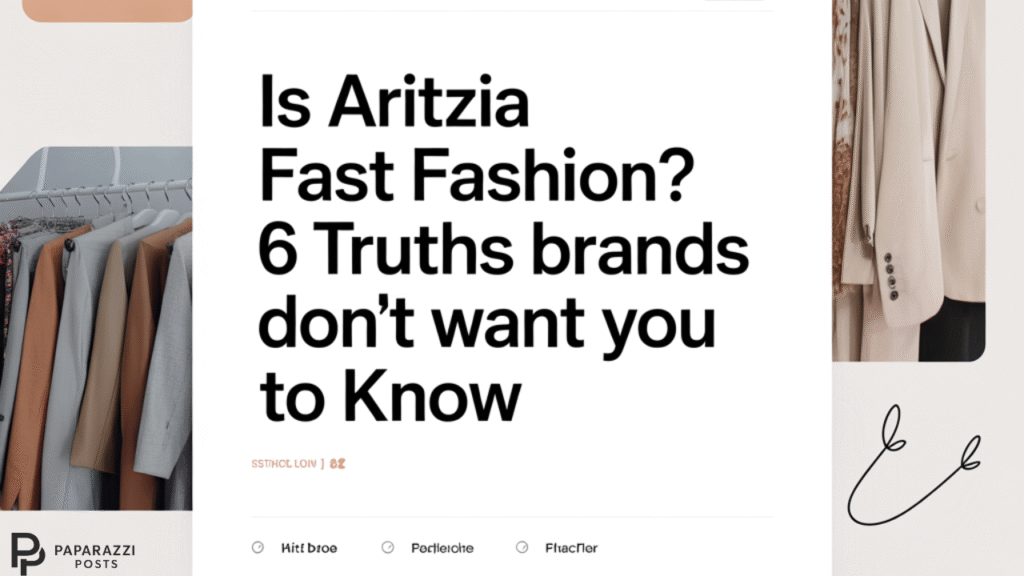When Aritzia opened its first U.S. stores, many shoppers perceived it as a breath of fresh air—modern, minimalist, and luxurious without the intimidating price tag of designer labels. However, beneath its polished aesthetic and artfully curated boutiques lies a business model that raises important questions. Is Aritzia fast fashion in disguise, wrapped in sleek packaging and elevated branding?
Aritzia has long described itself as an “everyday luxury” retailer, focusing on quality and timeless style. Yet, its operational structure—frequent new collections, trend-based turnover, and high production volumes—bears many hallmarks of the fast fashion system. The company’s rise to prominence in North America highlights a key paradox of modern retail: how brands can maintain a premium image while employing strategies strikingly similar to mass-market fashion giants.
Setting the Stage: What “Fast Fashion” Really Means
To determine whether Aritzia fast fashion truly exists, we must first define what fast fashion entails. Fast fashion is a business model designed to deliver the latest trends from the runway to the consumer in record time. This rapid production cycle often comes at a cost—environmental degradation, labor exploitation, and poor garment quality. Academic research estimates that the fashion industry generates over 92 million tons of textile waste annually, much of it linked to fast fashion’s disposable culture.
Brands like Zara, H&M, and Shein are classic examples—producing massive quantities of garments in short periods, constantly refreshing their catalogs to keep consumers buying. Yet, fast fashion is not defined solely by low prices. The true indicator lies in production methods, transparency, and sustainability. As researchers have noted, “Fast fashion is not just about affordability—it’s about accelerating consumption through psychological manipulation and supply chain speed.”
This definition complicates the question, is Aritzia fast fashion, since price alone cannot distinguish a brand’s ethical footprint. Instead, the deeper question is whether Aritzia’s pace of production, sourcing methods, and marketing align more closely with sustainability or disposability.
Aritzia’s Position in the Market
The “Everyday Luxury” Narrative
Aritzia’s marketing revolves around creating an aspirational yet accessible identity. It doesn’t want to be seen as cheap or disposable, but as a brand for women who appreciate minimalist elegance and longevity. Its stores are beautifully designed, with carefully crafted lighting and curated playlists meant to evoke a boutique experience rather than a mall atmosphere.
However, that image doesn’t automatically absolve it of fast fashion traits. Aritzia releases new products frequently and refreshes collections seasonally. The brand operates through multiple sub-labels—Wilfred, TNA, Babaton, Sunday Best, and Denim Forum—each targeting a specific demographic or aesthetic. This internal diversification allows the company to capture a wide consumer base, from Gen Z trendsetters to professional millennials.
According to Business of Fashion, Aritzia’s “superfan” culture fuels its success. Customers feel they belong to a style community built on confidence and coolness. Yet this attachment also drives repeated purchases—an emotional cycle central to fast fashion’s psychology.
Growth Strategy & Product Volume
Aritzia’s expansion strategy offers additional clues. Over the past five years, the brand has opened dozens of new stores in the U.S., significantly increasing its global production capacity. This growth requires massive inventory turnover and rapid restocking, both key features of fast fashion’s scalability.
Although its price points are higher than typical fast fashion chains, the underlying logistics—outsourced production, mass manufacturing, and high seasonal variability—remain strikingly similar. Many of its fabrics, like polyester and viscose, are synthetic or semi-synthetic, chosen for affordability and versatility rather than ecological responsibility. This balance between premium perception and industrial production underscores why many analysts still ask: “Is Aritzia fast fashion behind the label of luxury?”
Evidence For and Against Labeling Aritzia as Fast Fashion
Arguments For Aritzia Being Fast Fashion
- Frequent Style Turnover & Trend Orientation
Aritzia continuously introduces new pieces inspired by micro-trends. This constant renewal pressures consumers to keep up, a psychological hallmark of fast fashion behavior. - Use of Synthetic Materials
A significant portion of Aritzia’s garments use polyester, nylon, and other petroleum-based materials. These are inexpensive to produce but environmentally costly, contributing to carbon emissions and microplastic pollution. - Opaque Supply Chains
Transparency remains one of Aritzia’s weakest points. Unlike leading ethical brands, it publishes limited data on factory locations, wages, and worker safety conditions. Without transparency, sustainability claims remain unverifiable. - Greenwashing Concerns
Aritzia’s marketing often highlights eco-friendly phrases like “sustainably sourced” or “environmentally responsible,” yet detailed progress reports and measurable targets are minimal. This selective disclosure leads many critics to view its campaigns as superficial. - Limited Circularity Programs
While Aritzia occasionally supports donation initiatives, it lacks large-scale recycling or garment take-back programs—essential steps toward reducing textile waste.
As one ethical fashion advocate bluntly said:
“Aritzia is still fast fashion. Higher prices don’t equate to fair wages or eco-friendly practices—they’re just part of the illusion.”
Arguments Against Labeling Aritzia as Fast Fashion
- Superior Quality and Fit
Many loyal customers argue that Aritzia’s clothing lasts longer and feels better than typical fast fashion apparel. The attention to tailoring, fabric selection, and minimalist design may encourage longer wear. - Moderate Production Cadence
Compared to ultra-fast brands like Shein, Aritzia’s product turnover is slower. It releases new collections by season rather than weekly, suggesting a slightly more sustainable rhythm. - Sustainability Initiatives
The company has committed to sourcing regenerative cotton and joining the Better Cotton Initiative. It has also banned fur and reduced packaging waste. These steps mark incremental, if insufficient, progress toward sustainability. - Position Between Luxury and Mass Market
Aritzia deliberately positions itself between two extremes—premium but not exclusive, accessible but not cheap. This unique placement fuels its brand loyalty and differentiates it from purely profit-driven fast fashion houses.
Despite these defenses, many experts argue that good intentions are not enough without full transparency. A brand may promote responsible fashion while still benefiting from the same systems it claims to oppose.
Expert Insight
It helps to hear from someone within the sustainability space.
“Brands need to be transparent about their materials and manufacturing processes so that consumers can make informed choices. Banning fur is a good start, but it’s not the only issue we need to address.” — Clare Press, Sustainability Editor
Her statement captures the heart of this debate: meaningful sustainability requires systemic change, not just surface-level promises. Aritzia’s commitment to banning fur is commendable, yet critics highlight deeper, unresolved questions about worker rights and material sourcing.
Academic studies support this perspective. Research from the Journal of Fashion Marketing and Management notes that consumer trust grows when brands disclose full supply chain data, while partial transparency often backfires—seen by many as corporate greenwashing rather than ethical progress.
Putting It Together: Is Aritzia Fast Fashion?
After examining the evidence, the most accurate conclusion is that Aritzia sits in a gray area—elevated fast fashion. It’s not as exploitative or disposable as ultra-fast competitors, but it’s far from being a slow, sustainable brand.
Its operational model—high production volumes, reliance on synthetic fabrics, limited labor transparency, and rapid style refreshes—aligns closely with fast fashion practices. Yet its marketing, boutique experience, and premium aesthetic conceal this reality behind a veneer of sophistication. In other words, Aritzia fast fashion operates under the guise of refinement, giving consumers the illusion of ethical indulgence.
That doesn’t make Aritzia inherently villainous, but it highlights the structural contradictions in today’s retail landscape. As long as consumers reward novelty and accessibility over durability and ethics, brands like Aritzia will continue to walk this tightrope between aspiration and exploitation.
Ultimately, is Aritzia fast fashion? The answer depends on which side of the fashion equation you emphasize—brand image or business mechanics. When viewed through the lens of environmental and ethical responsibility, Aritzia mirrors fast fashion far more than it distances itself from it.
What This Means for U.S. Consumers
For conscious consumers in the United States, the implications are significant. Fast fashion’s allure is rooted in accessibility and aesthetic satisfaction, but it often conceals social and ecological costs. To make better choices:
- Demand transparency: Ask Aritzia where your clothes come from. Brands must feel consumer pressure to reveal factory and wage data.
- Prioritize longevity: Buy fewer items, focusing on timeless wardrobe staples rather than fleeting trends.
- Support secondhand options: Resale markets and consignment stores extend the lifespan of clothing and reduce waste.
- Engage in brand accountability: Comment on social media, sign petitions, and support policies that hold brands responsible for environmental impact.
- Educate yourself: Recognize how marketing influences consumer behavior and identify real sustainability over buzzwords.
By holding brands accountable, consumers shift the balance of power. Aritzia’s sophisticated image thrives on perception; changing consumer expectations can push it toward true transparency.
Conclusion
In conclusion, Aritzia fast fashion represents the new face of the fashion paradox—where luxury aesthetics coexist with mass production mechanics. The brand’s growth and success prove that modern consumers crave sophistication at scale, even if that sophistication masks traditional fast fashion practices.



1 Comment
Pingback: Echo Lake SageLife Senior Living: 7 Powerful Reasons It’s the Future of Retirement Living